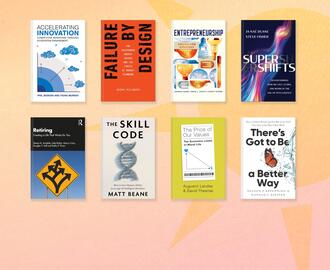When it comes to corporate finance, Stewart Myers wrote the book—and some of the most important papers, too. “No one outclasses him in terms of ideas that have staying power,” says Douglas Diamond, a professor of finance at the University of Chicago Booth School of Business and last year’s Fischer Black Visiting Professor of Finance at MIT Sloan. Jeremy Stein, a professor of economics at Harvard University who taught at MIT Sloan for ten years, says he teaches ideas from Myers to all of his PhD and undergraduate students. “That’s day two and day three,” he says. “His papers are the bedrock of the field some 30 years later.” Even today, colleagues remark, Myers continues to innovate. “At conferences, you can’t predict what he’s going to say based on what he did 20 or 30 years ago,” Diamond says. “He’s always thinking new things.”
But in five decades as the go-to expert in his field, Myers—a finance professor at MIT Sloan—did something else remarkable. He earned the respect, admiration, and affection of everyone he’s worked with. Perhaps more than his seminal contributions to corporate finance, this, his colleagues say, is why Stew Myers matters.
Why Stew Myers matters to MIT Sloan
Myers joined MIT in 1966. His arrival coincided with a seismic shift. “Up until the 1950s, business schools essentially transmitted the craft that had been developed by people who ran businesses,” says Dean Emeritus William Pounds. A 1954 study sponsored by the Ford Foundation set out to reform business education with a new research-based approach. “Sloan and Carnegie, where I went to school, were two schools that started after this report was written,” Pounds says. “When I became dean, MIT was kind of a startup. We had no faculty of the old type, which was a luxury.”
Pounds, with considerable help from economist Paul Samuelson, recruited Myers, along with Robert Merton, Myron Scholes, and Fischer Black. The young team represented a business school reboot. “They almost didn’t know how to spell finance,” Pounds recalls. “They were interested in how capital markets work.” Their ideas were not complicated, Pounds says, but they were “absolutely brand new and somewhat shocking to the system. What they did was thought by many to be silly excursions, but they came to define the way the financial world works.”
Myers focused on taking the mechanics of big markets and applying them to corporations. “There were a number of people now immortalized by Nobel Prizes who studied capital markets more generally. Stew nailed down the field of corporate finance,” Pounds says.
Stewart Myers in 1978
The new business school model became the standard, and Stew Myers was an important factor in MIT Sloan’s success. “Although MIT finance was a tiny fraction of the size of the leading finance departments of Chicago and Wharton at the time, it established a research reputation on a par with both,” says Nobel laureate Robert Merton, a colleague at MIT Sloan. “The teaching program Sloan created was innovative, and it attracted a lot of students. The impact on MIT finance, and on the field of finance, was enormous, and it’s still felt today, a half a century after Stew walked into Sloan for the first time.”
Adds Pounds, “Stew is the perfect example of what we hoped would happen. He attracted young colleagues who were inspired by what he represented. He made the whole school stronger, because schools are basically what their faculties are.”
Why Stew Myers matters as a teacher and a mentor
Research and teaching are not always mutually compatible skills, but Myers came to excel at both. “My recollection is that in the beginning, he was not seen as a very effective teacher,” Pounds says. “We arranged to overlook that possible disadvantage. He gradually became one of the most popular and effective teachers. He was good at the whole package.”
Raghuram Rajan, now the governor of the Reserve Bank of India, was a student, and then a teaching and a research assistant, and is now a co-author of Myers. For Rajan, Myers is defined by his role as thesis advisor. “Many advisors are happy to work with smarter students because the students’s success will reflect back on them. Stew worked with a lot of us who needed support, to help us do better. Some turned out to be good and some not so good; he didn’t care. He thought it was his duty,” Rajan says. “You see that again and again in Stew, and that was a phenomenal lesson for many of us who have become professors since.”
Rajan adds that Myers and his late wife Maureen generously hosted students at their home. “When you go to a professor’s house, some would gauge the capacity of students to have a taste for good wine and give them plonk because they wouldn’t know any better. But there was always really nice wine at Stew’s house.”
That generosity of spirit extends from home to the office and the conference circuit. Bart Lambrecht, a professor of finance at Cambridge Judge Business School, spent a sabbatical at MIT and has co-authored five papers with Myers. “Often I come up with an idea and it may be a little bit half-baked,” he admits. “In academics, people can be fairly dismissive. But rather than dismissing my idea, Stew will start probing me about it. He’s got this Socratic way of asking questions. And gradually as he’s asking questions, you figure out yourself that there are some issues. You start to understand the problem better. You get a better insight into what the problem is, and how you can move forward.”
Why Stew Myers matters as a colleague
Lambrecht and others describe Myers as a towering figure both physically and intellectually. Lambrecht recalls watching Myers flip a small boat onto his back and carry it down from his Maine cabin to the water. “I’m short, and when I stand next to him I literally look up; Academically, I feel the same way. But he’s a gentle giant. Academics are not always so gentle with each other. That’s quite refreshing.”
Jeremy Stein agrees. “When I got to MIT in 1990 it was the first time I really discovered Stew’s work,” he says. Stein told another professor, David Scharfstein, that Stew had basically invented the field of corporate finance. When Scharfstein relayed the compliment, Myers said “I always thought it was Modigliani and Miller.” Stein continues, “If you look at his textbook, in spite of the fact that his academic papers are central ideas, he doesn’t feature them heavily. He’s a brilliant guy who puts on no airs whatsoever.”
Even after 15 years in the same department, says MIT Sloan finance professor Antoinette Schoar, “I still learn something new each time I talk to him or hear his comments in our seminars.” But Myers manages to infuse his love for finance even into everyday life. In Schoar’s second year, Myers started a department tradition, devising challenges such as best name for a finance-inspired martini. “I am still waiting for one of our students to come up with ‘The Stew Myers,’” she says.
The MIT Sloan Finance Group held a fireside chat honoring Stewart Myers on April 29, 2016. See video of the event.




